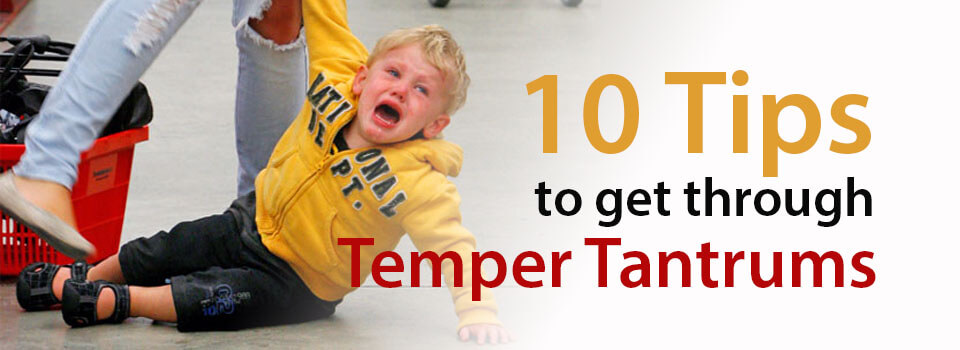10 Tips to Get Through Temper Tantrums
“Whatever is begun in anger, ends in shame.”
Happy Friday everyone. Here’s something for you to help you head into the week-end, whether you’re off to birthday parties, indoor playgrounds, shopping at the mall or just hanging out in your pj’s…here are a few tips on “Taming Tantrums”
A tantrum says “I have tried desperately to make the world go my way” Becky A. Bailey PhD Benjamin Franklin said this “Whatever is begun in anger, ends in shame.”
You are in the supermarket. You are at the doctor’s office or you’ve just arrived at the grandparents for a large family dinner. Perhaps you are simply preparing to head out the door for daycare. No matter where you might be and for no apparent reason, your child has just begun a temper tantrum. Embarrassment and frustration are welling up inside you. It seems that your child is not the only one who is losing control. You just want to run out of the room or put a paper bag over your head so that no one can see the oncoming tantrum beginning in your own head.
Think about what happens to us physically, emotionally and intellectually, when the world does not go our way.
If you want to have examples of adults who tantrum, just take a trip in your car, you are bound to see at least one.
How do you respond when your plans are thwarted, when the world doesn’t go your way?
I was driving the other day, just rounding the corner of my street when my neighbor just cut me off. I had that familiar adrenaline rush and tried hard to push away the rising anger and need to “tell him a thing or two!”
You can also find some questionable reactions on Facebook when a favorite T.V. program turns out to be a repeat. Is this the adult version of a temper tantrum?
The question is, what do we do about them? What can parents do to help children through tantrums?
What happens when you take a toddler away from her play to change a diaper, or when you tell your pre-schooler they’ve had enough cookies or when you are in the toy store buying a gift and your child wants something too?
You’re trying to get the day going, you give your 2 year old the “wrong cereal” because the one she wants was finished yesterday. Oh if only you had remembered to buy the same cereal! What’s happening to your own body right now? You might feel compelled to do anything just to make the screaming stop.
How many of you are more angry with your response than with your child’s tantrum?
Having a plan is half the battle even if the tantrum occurs:
A few developmental tidbits:
- Newborns: It’s important to keep in mind that your baby is able to communicate discomfort right at the earliest stages of life. Letting you know through crying that they are hungry or in pain helps you to answer to your baby’s needs. If you view your baby’s crying as normal and a healthy way of expression you will naturally convey that with a certain type of peace. You are giving the message that all feelings are okay. If you are so deeply distressed by the crying or tears, your baby can feel that too.
- Around 18 months of age a child begins this internal struggle for autonomy. Anger is not always a response to pain and discomfort, it is an intentional way to assert independence.
Assertive anger often comes from frustration. Your toddler reaches for a toy that he wants and cannot get to it, and so his frustration leads to anger and then he may become more assertive.
One reason a preschooler may become frustrated is that they are working on physical and verbal skills in order to complete tasks. They have not yet developed self control to tolerate failure. A frustrated child may start crying, throw something or hit someone.
It’s easy to see this behavior as a negative emotion. So if your 3 year old throws a tantrum you may feel that you want to reprimand him, give a time out or take something away. Children need to understand where their anger is coming from.
We need to teach children that it is okay to be angry, it is not okay to hit your brother.
Did you know that learning about anger is an important part of development?
Some children need to be encouraged to say they are angry. If they don’t learn this skill they will have trouble being assertive. If your child is having many out- bursts then let’s look at all the rules and see where we can ease up and try to be less rigid. Concentrating on 2 very meaningful rules will ensure better success than enforcing 10.
10 tips to get through Temper Tantrums:
- There are different ways to say “no” and we want to save “no” for safety issues. You can say “ It’s not a 3 cookie day but I have great news: tomorrow is cookie time again!”
- Dollar store shopping is an alternative to saying no to another toy. Or consider gift shopping on your own if that’s possible. Think about it-you’re taking your child to a toy store!!!!
- “I know you really wanted that cereal, wouldn’t it be great if there were lots of boxes. You can eat this cereal or have something else”. Your child may still scream loudly and refuse to choose anything else. That is okay. You are teaching your children to be decision makers. Not choosing to eat might not be your favorite choice but it is theirs. They may have regrets but that is okay too. They can always eat something once they’ve calmed down. When we become really invested in their emotions then there is chaos. Trying to run around finding solutions, getting upset or bribing them with promises of a treat later on only tell children that they have something to scream about. They need to know that it is okay when something does not go as planned.
- When you tell a child what they can’t do, tell them what they can. That plant is not for touching, look at it, see the colors, smell it, help me water it when it is watering time .
- Threats only set a child up for failure. If you touch that plant you will not be allowed to play in here. It is developmentally appropriate for a young child to check out if you are telling the truth. Say what you mean, mean what you say.
- While in a tantrum, children cannot really hear, keep your words limited but your body language very evident-calm and control, tone of voice, gestures etc…
- Always remember to discipline yourself first. Take several deep breaths before you begin to speak. Make yourself as calm as you would wish your child to be. When your child is experiencing a difficult emotion, they need to feel your calm, your peace, this is where their safety comes in.
- Empathize and validate: you are very angry, you really want that cookie. Wouldn’t it be great if we could have many cookies but we need to take care of our bodies.
- Remember that tantrums feed off the energy and attention we give them, so keep yourselves in the place of personal peace and validate, not too lengthy , re-read the above 2 points. You need to be authentic.
- Do not experience your child’s tantrum.
When your child is having a tantrum they look like they are falling apart. Your child is not falling apart. We put adult interpretations onto our children’s emotions.
Our reality is not their reality.
Our focus must be on helping children instead of stopping, ignoring, distracting, waiting for it to pass and yes even consequences.
When do we give a consequence concerning a tantrum? I believe it is not for the tantrum itself but rather for what might have happened as a result.
It is okay for a child to tantrum unless they are hurting themselves, hurting someone else or damaging property.
Remember that your children’s reality will unfold over and over again as they grow and as their world becomes bigger. They want you off the phone, they want to play longer, they want to stay up later, maybe as late as their brother or sister and they don’t want to eat what you’ve served for dinner.
Little eyes are watching you, they are imitating you and they are trusting you. Trust them back and make sure your message is “I know you can do this, I believe in you and you are well loved”.






